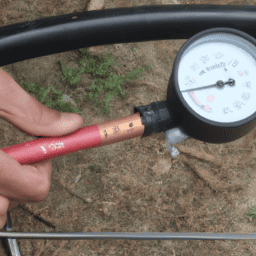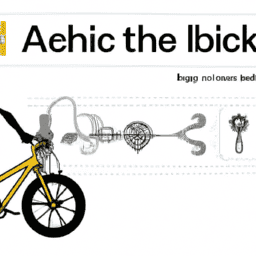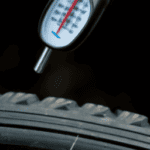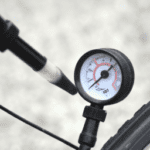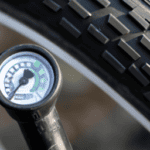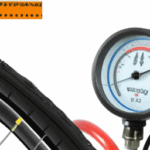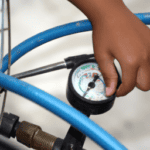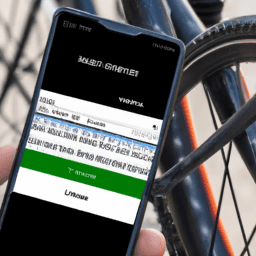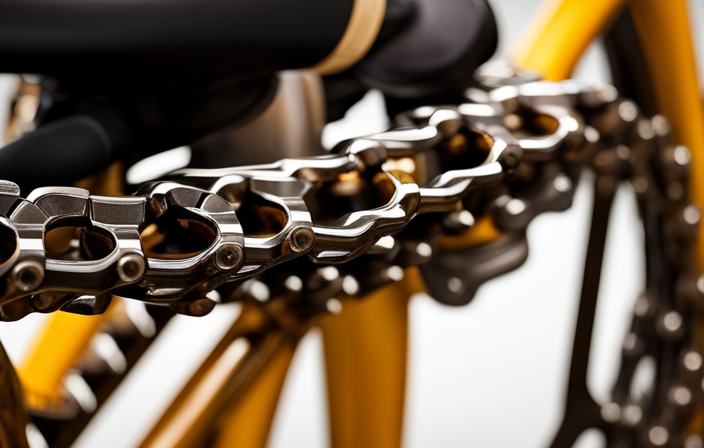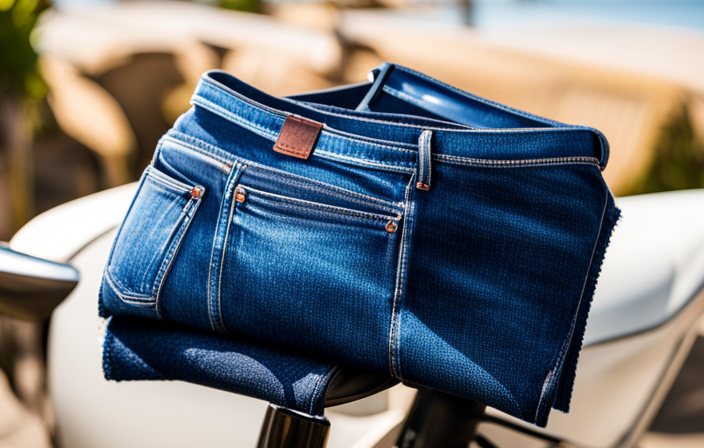As someone who loves cycling, I find it crucial to regularly inflate my bike tires. Riding on tires with insufficient pressure can be risky, leading to potential flats, lessened handling, and accidents. Yet, learning the proper way to inflate bike tires isn’t innate knowledge for all.
In this article, I will guide you through the step-by-step process of how to fill bicycle tires, so you can ride with confidence and avoid any potential mishaps on the road.
To begin with, you will need to determine the recommended tire pressure for your bike. This information can usually be found on the tire itself or in the owner’s manual.
Once you know the recommended tire pressure, you can gather the necessary equipment, which includes a pump with a pressure gauge, a tire lever, and a valve adapter if your pump does not fit the valve on your tire.
With your equipment ready, you can then prepare your bike and pump, making sure that the valve stem is clean and free of debris, and that the pump is securely attached to the valve.
With these preliminary steps completed, you are now ready to inflate your tires to the correct pressure.
Key Takeaways
- Proper tire pressure is essential for safety and optimal performance.
- Necessary equipment includes a pump with a pressure gauge, tire lever, and valve adapter.
- Valve adapters must be selected carefully for a secure fit and accurate pressure reading.
- Tire pressure must be checked regularly and adjusted as needed for different terrains or weather conditions.
Determine the Recommended Tire Pressure
You’ll want to check the recommended tire pressure on the sidewall of your bike’s tires, as it can vary depending on the brand and model. It’s essential to maintain the correct tire pressure in your bicycle for optimal performance and safety.
Riding with underinflated or overinflated tires can increase the risk of a puncture, reduce the lifespan of your tires, and affect your bike’s handling. There are various factors affecting tire pressure, such as the rider’s weight, terrain, and weather conditions.
It’s crucial to adjust the tire pressure based on these factors to ensure a comfortable and safe ride. Before filling your bicycle tires, make sure to gather the necessary equipment to avoid any interruption while inflating your tires.
Gather Necessary Equipment
Before filling my bicycle tires, I make sure to gather the necessary equipment. I always have a reliable pump with a pressure gauge handy to ensure that I’m filling my tires to the correct pressure.
Additionally, I keep valve adapters on hand in case I need to fill tires with different types of valves. Having the right equipment ensures that I can fill my tires properly and ride safely.
Reliable Pump with a Pressure Gauge
To get the most out of your ride, grab a pump with a pressure gauge so you can easily fill your bicycle tires to the correct level.
There are two types of pressure gauges: analog and digital. Analog gauges are the most common and are typically less expensive than digital ones. They use a needle to indicate the pressure level and are easy to read. Digital gauges are more precise and can be easier to use in low light conditions. They have a digital display that shows the pressure level in PSI or BAR.
When choosing the right valve adapter, it’s important to know what type of valve your bike has. There are two main types of valves: Presta and Schrader.
Presta valves are common on road bikes and have a narrow stem with a small knob on top that you unscrew to release air. Schrader valves are found on most mountain bikes and have a wider stem with a spring-loaded valve core that you depress to release air.
Make sure you choose an adapter that is compatible with your valve type. With a reliable pump and the correct valve adapter, you’ll be ready to fill your bike tires to the correct pressure level.
Valve Adapters (if necessary)
When selecting a valve adapter for your bike pump, it’s essential to determine the type of valve your bike has, whether it be Presta or Schrader. Different types of valve adapters are available in the market, each designed to fit a specific valve type. A valve adapter is a small, inexpensive accessory that connects your pump to the valve on your bike tire. It allows you to inflate your tires with a pump that may not fit the valve directly.
The table below lists the different types of valve adapters, their compatibility, and pros and cons of using each type. Using a valve adapter can be beneficial when you have a pump that does not fit your valve, but it can also add complexity to the process. It’s essential to choose the right adapter for your valve and pump to ensure a secure fit and accurate pressure reading. Once you have selected the right valve adapter, you can move on to preparing your bike and pump for inflating your tires.
| Valve Adapter Type | Compatibility | Pros | Cons |
|---|---|---|---|
| Schrader to Presta | Fits Schrader valves and allows inflation with Presta pump. | Inexpensive, easy to use. | May not provide accurate pressure reading. |
| Presta to Schrader | Fits Presta valves and allows inflation with Schrader pump. | Inexpensive, easy to use. | May not provide accurate pressure reading. |
| Presta extension valve | Fits Presta valves and extends valve for easier access with pump. | Provides accurate pressure reading, easy to use. | Adds complexity to the process. |
| Schrader valve to Dunlop | Fits Schrader valves and allows inflation with Dunlop pump. | Inexpensive, easy to use. | May not provide accurate pressure reading. |
| Dual head valve adapter | Fits both Presta and Schrader valves. | Versatile, provides accurate pressure reading. | May add complexity to the process. |
With the right valve adapter selected, the next step is to prepare your bike and pump for inflating your tires.
Prepare Your Bike and Pump
First, I remove the valve cap from my bike tire to expose the valve stem.
Then, I attach the pump to the valve stem by pressing the pump head onto the stem firmly.
Lastly, I ensure that the pump is properly secured to the valve stem by checking that there’s no air escaping from the connection.
Remove Valve Cap
Before inflating your bicycle tires, start by removing the valve cap to access the valve stem. The valve cap protects the valve stem from dust and debris, and it needs to be removed before attaching the pump. Valve cap removal is an easy and straightforward process that does not require any specialized tools. Simply use your fingers to twist the cap counterclockwise until it comes off. Be careful not to lose the cap as it is an important part of the valve stem.
To help you understand the different valve types and how to remove their caps, refer to the table below:
| Valve Type | Valve Cap Removal |
|---|---|
| Schrader | Twist off |
| Presta | Unscrew |
| Dunlop | Push and twist |
| Woods | Push and twist |
Once you have removed the valve cap, you can move on to the next step, which is attaching the pump to the valve.
Attach Pump to Valve
To properly inflate your bike tires, you’ll need to attach the pump to the valve stem using a quick and easy process.
First, ensure that the valve is in the proper position by rotating it to be perpendicular to the ground. This will prevent any air from escaping during inflation.
Next, choose the correct pump head for your valve type – either Presta or Schrader. Once you’ve selected the appropriate head, simply push it onto the valve stem and lock it in place.
Now that the pump is attached, you can begin inflating your tire. Pump up and down to build air pressure inside the tire, and monitor the pressure using a pressure gauge.
If you encounter any issues, such as air leaking from the valve or difficulty pumping, double check that the valve is still perpendicular to the ground and try again.
With these simple steps, you can easily attach your pump to the valve and begin inflating your tires to the proper pressure for a smooth and safe ride.
Inflate Your Tires
Pump up those tires with a powerful push of air to ensure a smooth and safe ride. Proper tire inflation is crucial for both performance and safety reasons.
Riding on underinflated tires can cause unnecessary wear and tear on your bike’s components, reduce your speed and maneuverability, and even lead to accidents. On the other hand, overinflated tires can make your ride uncomfortable, decrease your grip on the road, and increase your risk of punctures.
To avoid these issues, follow these steps to inflate your bike tires correctly. First, check the recommended pressure range for your tires, which is usually printed on the sidewall.
Then, attach the pump to the valve and push down on the lever to lock it in place. Finally, pump the handle up and down until you reach the desired pressure, using a pressure gauge if available. Be careful not to overinflate the tires, as this can cause them to burst.
Also, check the tire pressure regularly and adjust it as needed, especially if you ride on different terrains or in different weather conditions. Now that you know how to inflate your bike tires properly, it’s time to finish up.
Check the valve for any leaks or damage, and replace it if necessary. Then, remove the pump from the valve, making sure to unscrew it carefully to avoid any air escaping. Finally, put the valve cap back on to protect it from dust and dirt.
With your tires fully inflated, you’re ready for a smooth and safe ride!
Finish Up
Now that you’ve checked the valve for leaks or damage, it’s time to remove the pump and put the valve cap back on. Before doing so, make sure you have inflated your tires to the recommended pressure level, which is typically indicated on the sidewall of the tire. It’s important to use the proper technique when filling your tires to ensure the best performance and longevity.
One common mistake people make when filling their tires is overinflating them. This can cause excessive wear and tear on the tire and may even lead to a blowout. On the other hand, underinflated tires can negatively impact your bike’s handling and may even cause damage to the rims. To avoid these issues, use a tire pressure gauge to ensure you’re filling your tires to the correct pressure level. Another important tip is to always use a pump with a pressure gauge, as this will help you achieve the desired pressure level more accurately.
| Common Mistakes | Proper Technique | Tips |
|---|---|---|
| Overinflating tires | Use a tire pressure gauge | Always use a pump with a pressure gauge |
| Underinflating tires | Fill to recommended pressure level | Check tire pressure regularly |
| Using a pump without a pressure gauge | Check the valve for leaks or damage | Avoid inflating tires in extreme temperatures |
By following these tips and using the proper technique, you can ensure your bike tires are filled to the correct pressure level, which will help you achieve better performance and longevity. Remember to check your tire pressure regularly and avoid inflating your tires in extreme temperatures, as this can affect the pressure level and lead to issues down the line. With a little bit of care and attention, you can enjoy a safe and comfortable ride every time you hit the road.
Frequently Asked Questions
How do I know if my bike tire needs to be replaced?
To determine if my bike tire needs to be replaced, I inspect for signs of Bike Tire Wear such as cracks or fraying, check for worn Tire Tread Depth, and examine for irregular Tire Wear Patterns. Additionally, some bikes have Tire Pressure Monitoring Systems as Replacement Indicators.
What type of valve should I look for when purchasing a bike pump?
After investigating, I found that there are two main valve types for bike pumps: Presta and Schrader. Pros and cons vary, but it’s important to know which type your bike uses. Regular maintenance can prolong valve health.
Can I use a regular air compressor to inflate my bike tires?
I do not recommend using a regular air compressor to inflate bike tires. Air compressors generate too much pressure, which can cause the tires to burst. Air compressor alternatives like a bike pump or CO2 inflator are safer and offer a proper tire pressure range.
How often should I check the tire pressure on my bike?
It’s important to regularly check tire pressure on my bike to ensure proper inflation. Weather can affect tire pressure, so I check before each ride. Proper inflation helps prevent flats and improves handling.
What should I do if my bike tire keeps losing air even after inflating it?
If my bike tire keeps losing air even after inflating it, I first check for any visible punctures or damage. If none are found, I troubleshoot leaks by applying soapy water and look for bubbles. If a leak is found, I use tire patching techniques to fix it.
Conclusion
In conclusion, filling bicycle tires is a crucial skill for every cyclist. It ensures that your bike is safe and efficient to ride and prolongs the lifespan of your tires. Remember the adage, "a stitch in time saves nine."
Regularly checking and inflating your tires can prevent a flat tire or even a blowout, saving you from costly repairs and injuries. By following the steps outlined above, you can confidently fill your bicycle tires without any hassle.
Remember to check your recommended tire pressure, gather the necessary equipment, and properly prepare your bike and pump. Inflating your tires to the correct pressure is essential, so take your time and monitor the gauge as you fill your tires. Don’t forget to finish up by securely replacing the valve caps and inspecting your tires for any signs of damage or wear.
In conclusion, taking care of your tires is taking care of your bike. So, make sure to keep them properly inflated, and you’ll enjoy a smoother and safer ride.
